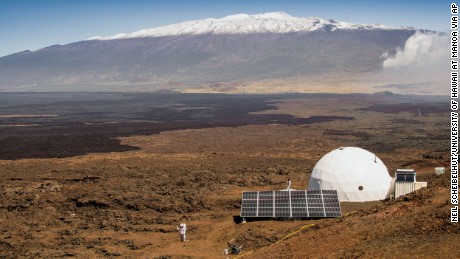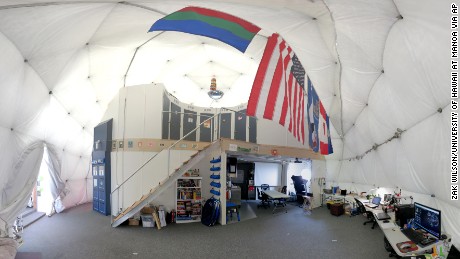(CNN)After eight long months cooped up in a plastic dome with five other people, what part of the outside world would you miss the most?
If you're anything like the six scientists who emerged this weekend from isolation high on Mauna Loa's arid, rocky slopes, the answer might be: wind.
"One thing was just being able to feel the breeze on our skin," project participant Jocelyn Dunne told CNN's John Vause via Skype from Hawaii.
"When you're in the spacesuit all you can feel is it pressing against you making it more difficult for you to walk in a certain direction but you don't actually have that sensation."

The six were taking part in a "Mars analog" experiment run by the Hawaii Space Exploration Analog and Simulation, or Hi-SEAS.
During the experiment's duration, the team lived together in a solar-powered geodesic dome and wore space suits when they emerged from their living quarters to simulate working on Mars' surface. Dunne also said that, along with the breeze, it was a novelty to see the outside world without the glare created by her visor.
Testing conditions
The aim of the project was to simulate the physical conditions of working on Mars -- including the effects of living in close quarters with five others for an extended period of time.
It was designed to give NASA a better idea of how to select -- and support -- astronauts for any future missions to the Red Planet.
"One of the hardest parts was not being able to get away," Dunne said. "You're always observable by the other people. You're constantly together. Even though we're isolated from the rest of the world we're constantly together in our own social situation."

As their long-awaited freedom beckoned, the six blasted Europe's 80's rock anthem "The Final Countdown" on repeat -- enough in itself for some people to look for an escape hatch -- ahead of a "Back to Earth" celebration, which included a skydive for the crew members facilitated by the the U.S. Army's Golden Knights parachute team.
The team is now free to enjoy Hawaii, the island paradise that was so achingly close for the past eight months. And according to Dunne, all that time cooped up together hadn't dampened the erstwhile roommates' friendships.
"We're all still great friends, and we'll definitely be planning reunions in the future."
Maybe just not eight-month-long ones.
Source Article from http://rss.cnn.com/~r/rss/cnn_tech/~3/ujKE_DVU764/index.html http://revealedtech.com/image/gif;base64,R0lGODlhEAAJAJEAAAAAAP///////wAAACH5BAEAAAIALAAAAAAQAAkAAAIKlI+py+0Po5yUFQA7
Scientists emerge from Hawaiian 'Mars'
No comments:
Post a Comment